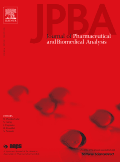
Journal of Pharmaceutical and Biomedical Analysis
Scope & Guideline
Exploring the intersection of analytical chemistry and biomedicine.
Introduction
Aims and Scopes
- Pharmaceutical Analysis:
The journal emphasizes the development and validation of analytical methods for the quantification of active pharmaceutical ingredients (APIs), excipients, and impurities in drug formulations. This includes techniques like HPLC, LC-MS/MS, and NMR. - Biomedical Analysis:
Research that investigates the pharmacokinetics, pharmacodynamics, and therapeutic effects of drugs in biological systems is a core focus. Studies often involve metabolomics and proteomics to elucidate drug action and interactions. - Quality Control and Assurance:
The journal covers methodologies for quality assessment of pharmaceutical products, including stability studies, impurity profiling, and compliance with regulatory standards. - Natural Products and Herbal Medicines:
Research involving the characterization and analysis of traditional medicines and natural products is highlighted, including their bioactive constituents and pharmacological effects. - Innovative Analytical Techniques:
The journal encourages the use of cutting-edge technologies such as mass spectrometry, chromatography, and biosensors for drug analysis, emphasizing the importance of novel methodologies in enhancing analytical performance. - Pharmacokinetic Studies:
Pharmacokinetic and pharmacodynamic studies utilizing advanced analytical techniques are a significant area of publication, focusing on drug absorption, distribution, metabolism, and excretion.
Trending and Emerging
- Metabolomics and Lipidomics:
Studies utilizing metabolomics and lipidomics to explore disease mechanisms, drug effects, and patient responses are increasingly prominent. This trend highlights the importance of understanding complex metabolic networks in drug development. - Biosensors and Point-of-Care Testing:
Research on biosensors and rapid diagnostic tools for real-time monitoring of drug levels and disease markers is on the rise, reflecting a growing interest in personalized medicine and accessible healthcare solutions. - Pharmacogenomics and Personalized Medicine:
Analyses that integrate pharmacogenomics into therapeutic strategies are gaining traction, emphasizing the need for individualized treatment approaches based on genetic profiles. - Advanced Drug Delivery Systems:
Innovations in drug delivery methods, including nanotechnology and targeted delivery systems, are emerging areas of research, highlighting the quest for improved efficacy and reduced side effects in pharmaceuticals. - Natural Products and Traditional Medicine Research:
There is a resurgence of interest in studying traditional medicines and natural products, particularly their active components and mechanisms of action, driven by a holistic approach to health and wellness. - Environmental Analysis of Pharmaceuticals:
Research focusing on the environmental impact of pharmaceuticals and the detection of contaminants in water and soil systems is trending, reflecting a global concern for sustainability and public health.
Declining or Waning
- Traditional Analytical Methods:
There appears to be a waning interest in conventional analytical methods, such as basic UV-Vis spectroscopy and simple HPLC methods, as researchers increasingly favor more sophisticated techniques that provide greater sensitivity and specificity. - General Drug Stability Studies:
There has been a noticeable decrease in studies focused solely on the stability of pharmaceutical compounds without integrating innovative analytical approaches or linking stability to pharmacological effects. - Non-Clinical Pharmacokinetic Studies:
Research that does not incorporate advanced modeling or translational aspects of pharmacokinetics is less frequent, as there is a growing emphasis on studies that can directly influence clinical practices. - Single Compound Focus:
There is a trend away from research that investigates a single compound in isolation, with more emphasis on multi-component systems and complex formulations that reflect real-world applications. - Basic Toxicology Studies:
Publications focusing solely on basic toxicology without a strong analytical or pharmacokinetic component have seen a decline, as the field moves towards integrated approaches that consider the full biological impact of compounds.
Similar Journals
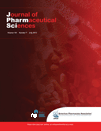
JOURNAL OF PHARMACEUTICAL SCIENCES
Pioneering insights in pharmaceutical sciences since 1961.The JOURNAL OF PHARMACEUTICAL SCIENCES, published by ELSEVIER SCIENCE INC, stands as a cornerstone in the field of pharmaceutical sciences, offering a platform for innovative research and advancements since its inception in 1961. With an impressive Scopus Rank of #36 out of 183 in the Pharmaceutical Science category, this journal is recognized for its commitment to disseminating high-quality, peer-reviewed studies that significantly contribute to the realms of pharmacology, toxicology, and pharmaceutics. Holding a 2023 Q2 category quartile, it attracts a diverse readership encompassing researchers, industry professionals, and students eager to advance their understanding and expertise. While the journal is not open access, it ensures valuable insights in every issue, making it an essential resource for those dedicated to the evolving landscape of pharmaceutical research. With an impact factor that reflects its relevance and influence, the JOURNAL OF PHARMACEUTICAL SCIENCES continues to shape the discourse in its domain, fostering innovation and collaboration among scholars worldwide.

MOLECULES
Innovative Research for a Global Scientific CommunityMOLECULES, published by MDPI, stands as a prominent open-access journal dedicated to the field of chemistry, with an exceptional reputation in various sub-disciplines. Since its inception in 1997, this journal has committed itself to the dissemination of innovative research, spanning topics in Analytical Chemistry, Organic Chemistry, Pharmaceutical Science, and Drug Discovery. With impressive rankings across Scopus categories—including a coveted Q1 designation in both Analytical Chemistry and Pharmaceutical Science—MOLECULES is recognized as a vital resource for researchers, professionals, and students aiming to stay at the forefront of scientific development. The journal’s data reflect its wide-ranging influence, holding high percentiles in multiple chemistry categories, thereby ensuring that its articles reach a significant audience. As an open-access journal, it provides unparalleled access to its content, available freely and globally, which promotes further advancement and collaboration within the scientific community. Its ongoing commitment to high-quality research from 1996 to 2024 reinforces its status as a leader in the academic publishing landscape.
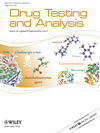
Drug Testing and Analysis
Connecting Research to Real-World Drug Safety SolutionsDrug Testing and Analysis is a leading scholarly journal published by WILEY, dedicated to advancing the field of drug testing and analytical methods. With ISSN 1942-7603 and E-ISSN 1942-7611, this journal provides a platform for the latest research in Analytical Chemistry, Pharmaceutical Science, and Environmental Chemistry, holding a prestigious reputation reflected in its Q1 and Q2 rankings across various categories in 2023. The journal promotes high-impact studies that explore innovative methodologies, with a specific focus on pharmacological and toxicological analyses, making it an essential resource for researchers, professionals, and students concerned with drug efficacy, safety, and environmental impact. With a strong commitment to quality and relevance, Drug Testing and Analysis remains at the forefront of contemporary scientific inquiry, contributing significantly to both academic and practical advancements in the industry.
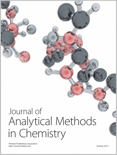
Journal of Analytical Methods in Chemistry
Fostering collaboration in the vibrant world of analytical science.The Journal of Analytical Methods in Chemistry, published by HINDAWI LTD, stands as a premier platform dedicated to the dissemination of research in the vibrant field of analytical chemistry. With an ISSN of 2090-8865 and an E-ISSN of 2090-8873, this Open Access journal has been committed to providing unrestricted access to quality research since 1978, thereby fostering greater collaboration and innovation among researchers, professionals, and students globally. The journal showcases rigorous research insights spanning diverse categories, earning impressive Scopus rankings including Q2 in Chemical Engineering and Q3 in Analytical Chemistry for 2023, positioning itself effectively among respected peers. Its interdisciplinary approach also covers significant contributions in the realms of instrumentation and computer science applications, thus addressing contemporary challenges and advancements in analytical methodologies. By bridging theoretical underpinnings with practical applications, the Journal of Analytical Methods in Chemistry aims to catalyze knowledge exchange while enhancing the global discourse in analytical science.

ACTA POLONIAE PHARMACEUTICA
Advancing Pharmaceutical Knowledge Since 1951ACTA POLONIAE PHARMACEUTICA is a well-established peer-reviewed journal published by Polskie Towarzystwo Farmaceutyczne, dedicated to the field of pharmaceutical sciences and pharmacology. With a rich history dating back to 1951, this journal serves as a vital platform for disseminating cutting-edge research and developments in pharmaceutical technology, drug development, and therapeutic therapies. Although it currently operates under a subscription model, its commitment to scientific rigor has earned it a respectable impact factor, placing it in the Q3 and Q4 quartiles respectively for Pharmaceutical Science and Pharmacology as of 2023. Researchers and practitioners alike will find value in its comprehensive coverage of essential topics, as well as its diverse range of contributions from both established and emerging scholars in the field. With its address located in the heart of Warsaw, Poland, ACTA POLONIAE PHARMACEUTICA aims to further bridge the gap between academia and industry, paving the way for innovation in drug discovery and therapeutic applications.
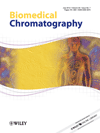
BIOMEDICAL CHROMATOGRAPHY
Innovating Analytical Techniques for Health SolutionsBiomedical Chromatography is a prestigious journal published by Wiley, focusing on the vital intersections of analytical chemistry, biochemistry, and clinical studies. With an ISSN of 0269-3879 and E-ISSN of 1099-0801, it has served the research community since its inception in 1986. The journal provides a platform for innovative research in areas such as drug discovery and pharmacology, achieving a commendable placement in Q3 across multiple categories in the 2023 metrics, including Analytical Chemistry and Biochemistry. Although it currently does not offer open access, it plays a crucial role in disseminating scientific developments and methodologies that contribute to advancements in health, safety, and pharmaceuticals. Researchers, professionals, and students can anticipate high-quality, peer-reviewed articles that drive forward the collective knowledge in biomedical applications. Located in the United Kingdom at 111 River St, Hoboken, NJ, the journal continues to attract contributions from global thought leaders in the field.
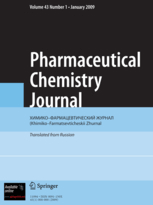
PHARMACEUTICAL CHEMISTRY JOURNAL
Advancing Drug Discovery Through Scholarly Excellence.Pharmaceutical Chemistry Journal is a pivotal publication in the field of pharmaceutical sciences, renowned for its in-depth articles and research findings. Published by Springer in the United States, this journal provides a crucial platform for researchers, students, and professionals dedicated to advancing drug discovery and pharmacology. With an ISSN of 0091-150X and an E-ISSN of 1573-9031, this journal has consistently aimed to promote scholarly communication and innovation within its scope since its inception in 1967. Despite its current Category Quartiles ranking of Q4 in both Drug Discovery and Pharmacology, the journal remains a valuable resource for disseminating new ideas and findings that contribute to the scientific community. Researchers benefit from the journal's commitment to high-quality peer-reviewed content, even in an environment where open access options are currently not available. As the field evolves, the Pharmaceutical Chemistry Journal continues to play an important role in shaping future advancements in drug development and safety.

Indian Journal of Pharmaceutical Education and Research
Empowering research, shaping pharmaceutical education.Indian Journal of Pharmaceutical Education and Research, published by the Association of Pharmaceutical Teachers of India, is a pivotal platform for scholarly discussion in the field of pharmacology, toxicology, and pharmaceutics. ISSN 0019-5464, this esteemed journal aims to foster the exchange of innovative research, clinical advancements, and educational practices within the pharmaceutical sciences community. As a Q3-ranked journal in its category as of 2023, it reflects a commitment to upholding the standards of academic excellence and contributes significantly to the ongoing development of pharmaceutical education. The journal is a valuable resource for researchers, professionals, and students, with content spanning various key areas including drug formulation, safety, and the latest trends in pharmaceutical education. By providing open access to its research and reviews, the journal ensures that vital information is disseminated widely, promoting collaboration and learning among stakeholders in the pharmaceutical sector. Based in Bangalore, India, the journal has been instrumental in highlighting regional research while fostering a global dialogue in pharmaceutical sciences. As it continues its journey from 2008 to 2024, it remains dedicated to impacting the field through rigorous peer-reviewed content and engaging with contemporary challenges in healthcare and education.

International Journal of Pharmaceutical Investigation
Fostering Dialogue on Cutting-Edge Pharmaceutical PracticesInternational Journal of Pharmaceutical Investigation, published by INPHARM ASSOC, PHCOG NET, is a premier platform dedicated to advancing the field of pharmaceutical sciences. With the ISSN 2230-973X and E-ISSN 2230-9713, this journal serves as a vital resource for researchers, professionals, and students focused on drug development, formulation, and efficacy. By fostering a rich discourse on innovative pharmaceutical practices and research breakthroughs, the journal plays a critical role in enhancing global health outcomes through groundbreaking scholarly work. The absence of open access allows for selective dissemination of high-quality content, promoting rigorous peer-review processes that uphold academic integrity. Featuring articles that span a diverse range of topics within pharmaceutical sciences, the International Journal of Pharmaceutical Investigation is committed to supporting the ongoing evolution of this dynamic field, making it an essential read for anyone engaged in pharmaceutical research and development.

Journal of Chemical Metrology
Empowering Researchers with Cutting-Edge MetrologyJournal of Chemical Metrology is a vital resource in the evolving fields of Analytical Chemistry, Electrochemistry, Spectroscopy, and Toxicology, published by ACG PUBLICATIONS in Turkey. With a focus on advancing the understanding and application of chemical metrology, this journal aims to bridge gaps in quantitative analysis, offering researchers and professionals a platform to disseminate groundbreaking studies and methodologies. Although it operates under a traditional access model, readers can benefit from its insights as the journal continues to gain recognition with its 2023 rankings placing it in the Q3 and Q4 categories across various scientific disciplines. From its inception in 2019 to its projected convergence in 2024, the journal has been instrumental in fostering collaboration and innovation in chemical sciences, making it an essential tool for students and researchers dedicated to enhancing analytical techniques and ensuring safety through effective toxicological assessments.